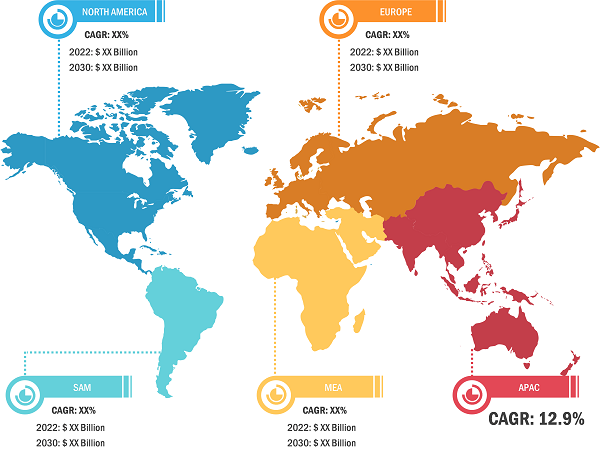Growing Demand for Traceability and Real-Time Monitoring to Offer Opportunities for RFID Market During 2023–2030
According to our latest study on "RFID Market Forecast to 2030 – COVID-19 Impact and Global Analysis – by Type, Frequency Band, End User, Product, Offering, and Application “ the market is expected to grow from US$ 16.83 billion in 2022 to US$ 39.30 billion by 2030; it is estimated to grow at a CAGR of 11.2% from 2023 to 2030.
RFID tags can be attached to patients' wristbands or belongings to track their location and status. They help prevent patient abductions and improves patient care. RFID tags can be attached to medication bottles to track inventory and ensure patients receive the correct medications. RFID tracking prevents medication errors, which can harm patients. In August 2021, Terso Solutions, Inc. deployed its RAIN Radio Frequency Identification (RAIN RFID) solutions in nearly 1,000 healthcare facilities in the US. The solution provides real-time visibility and can be integrated into existing EHR/ERP systems through the cloud-based software of Terso Solutions, Inc. Additionally, in February 2022, Impinj, Inc. joined the DoseID Consortium to increase its emphasis on RAIN radio-frequency identification (RAIN RFID) applications in the healthcare sector. Also, Impinj, Inc. collaborates with healthcare providers to contribute to the development of RAIN RFID standards by utilizing its RAIN RFID technology. Using this technology, the company creates solutions to enhance patient care, save costs, and boost efficiencies by automating systems that protect patients and employees, and better manage assets and inventories.
RFID Market — by Region, 2022
RFID Market Forecast to 2030 - Global Analysis by Type (Active and Passive), Frequency Band (Low Frequency, High Frequency, and Ultrahigh Frequency), End User (Public Sector, Healthcare, Education, Sports & Recreation, Hospitality, Residential, BFSI, Manufacturing, Telecommunications, and Others), Product (Cards, Key FOBs, Smartphones, Bands, and Others), Offering (Tags, Readers, and Software & Services), and Application (Parcel & Mailboxes, Lockers, Ticketing, and Others)
RFID Market Size Report & Industry Overview 2023 to 2030
Download Free Sample
Source: The Insight Partners Analysis
The North America RFID market is further segmented into the US, Canada, and Mexico. RFID can be used in omnichannel retail businesses to improve customer experience, enhance efficiencies, and reduce costs. RFID can be used to track items in stores so that customers can easily pick up the products for which they have placed online orders, which saves them time. PUMA SE is deploying RFID technologies in its stores to enhance the customer experience. In October 2022, Nedap N.V. partnered with PUMA SE in North America for the rollout of RFID. It has deployed the RFID technologies in 135 PUMA SE stores across the region to allow the store operators to keep regular stock counts and ensure efficient replenishment. These solutions enable smart refill suggestions and data-driven loss prevention. In October 2020, Fujitsu Frontech North America Inc launched its RFID for the garment and uniform rental businesses. With its UHF RFID garment tags, garment companies can enable sophisticated garment tracking and asset management. These are transparent, washable tags with a thickness of 0.6 mm. Such product launches and partnerships encourage the adoption of RFID technologies in North America.
The RFID market is segmented into type, frequency band, end user, product, offering, and application. Based on type, the is bifurcated into active and passive. The RFID market, by frequency band, is categorized into low frequency, high frequency, and ultrahigh frequency. Based on end user, the market is bifurcated into public sector, healthcare, education, sports & recreation, hospitality, residential, BFSI, manufacturing, telecommunications, and others. The market, based on product, is categorized into cards, key fobs, smartphones, bands, and others. In terms of offering, the RFID market is categorized into tags, readers, and software & services. The RFID market, by application, is categorized into parcel & mailboxes, lockers, ticketing, and others.
Zebra Technologies Corp; Siemens AG; Honeywell International Inc; Assa Abloy AB; and MIWA LOCK Co Ltd are a few of the key players profiled during the study on the RFID market. Several other major RFID market players were also studied and analyzed to get a holistic view of the market and its ecosystem. The RFID market growth report provides detailed market insights, which would help key players strategize their growth.
The imposition of strict regulations by the US government in the Q2 of 2020 restricted all human activities, which led to a temporary halt in all manufacturing activities. Moreover, the temporary suspension of all production activities in industries such as pharmaceuticals, food & beverages, and chemicals hampered the of the RFID market growth during the pandemic. However, the market started to recover as soon as lockdown restrictions were revoked and manufacturing businesses resumed their operations.
Various RFID manufacturers in North America started launching their products during the post-COVID-19 recovery period. In October 2020, Fresenius Kabi AG launched its first RFID smart-labeled product in the US. The smart label enables hospitals to automatically identify, locate, and manage their inventory.
While the pandemic spurred demand for contactless access control solutions, it also caused disruptions in manufacturing and delivery operations. Moreover, economic uncertainty resulted in a low demand for high-end electronics and semiconductors. Hence, the COVID-19 pandemic had a mixed impact on the North American RFID market player.
Contact Us
Phone: +1-646-491-9876
Email Id: sales@theinsightpartners.com